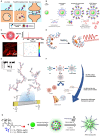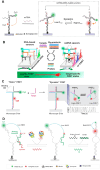Advancements in Single-Molecule Fluorescence Detection Techniques and Their Expansive Applications in Drug Discovery and Neuroscience
- PMID: 40422023
- PMCID: PMC12109833
- DOI: 10.3390/bios15050283
Advancements in Single-Molecule Fluorescence Detection Techniques and Their Expansive Applications in Drug Discovery and Neuroscience
Abstract
Single-molecule fluorescence technology stands at the forefront of scientific research as a sophisticated tool, pushing the boundaries of our understanding. This review comprehensively summarizes the technological advancements in single-molecule fluorescence detection, highlighting the latest achievements in the development of single-molecule fluorescent probes, imaging systems, and biosensors. It delves into the applications of these cutting-edge tools in drug discovery and neuroscience research, encompassing the design and monitoring of complex drug delivery systems, the elucidation of pharmacological mechanisms and pharmacokinetics, the intricacies of neuronal signaling and synaptic function, and the molecular underpinnings of neurodegenerative diseases. The exceptional sensitivity demonstrated in these applications underscores the vast potential of single-molecule fluorescence technology in modern biomedical research, heralding its expansion into other scientific domains.
Keywords: biosensor; drug discovery; neuroscience; single-molecule fluorescent probe.
Conflict of interest statement
Authors Lin Cheng, Yitong Li and Ru Wang were emplayed by Holosensor Medical Technology Ltd., Suzhou 215000, China. The remaining authors declare that the research was conducted in the absence of ant commercial or financial relationships that could be construed as a potential conflict of interest.
Figures







Similar articles
-
Fluorescent Biosensors Based on Single-Molecule Counting.Acc Chem Res. 2016 Sep 20;49(9):1722-30. doi: 10.1021/acs.accounts.6b00237. Epub 2016 Sep 1. Acc Chem Res. 2016. PMID: 27583695 Review.
-
Fluorescent biosensors - probing protein kinase function in cancer and drug discovery.Biochim Biophys Acta. 2013 Jul;1834(7):1387-95. doi: 10.1016/j.bbapap.2013.01.025. Epub 2013 Feb 1. Biochim Biophys Acta. 2013. PMID: 23376184 Review.
-
Application of Fluorescence- and Bioluminescence-Based Biosensors in Cancer Drug Discovery.Biosensors (Basel). 2024 Nov 24;14(12):570. doi: 10.3390/bios14120570. Biosensors (Basel). 2024. PMID: 39727835 Free PMC article. Review.
-
Fluorescent biosensors of intracellular targets from genetically encoded reporters to modular polypeptide probes.Cell Biochem Biophys. 2010;56(1):19-37. doi: 10.1007/s12013-009-9070-7. Cell Biochem Biophys. 2010. PMID: 19921468 Review.
-
Single-molecule biosensors: Recent advances and applications.Biosens Bioelectron. 2020 Mar 1;151:111944. doi: 10.1016/j.bios.2019.111944. Epub 2019 Dec 9. Biosens Bioelectron. 2020. PMID: 31999573 Review.
References
Publication types
MeSH terms
Substances
LinkOut - more resources
Full Text Sources

